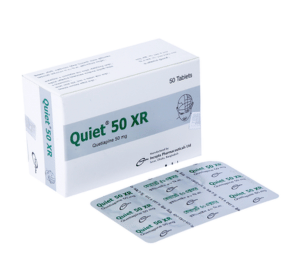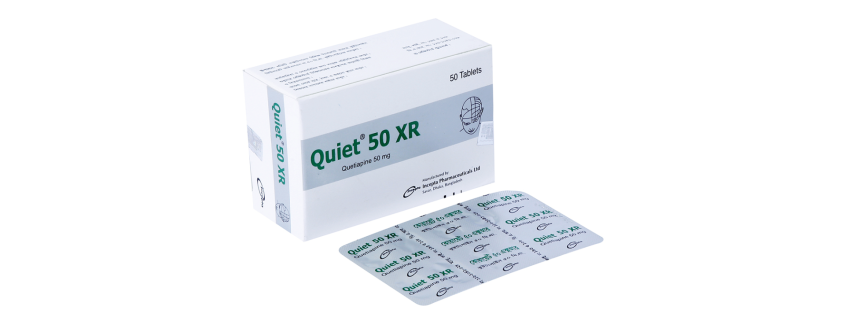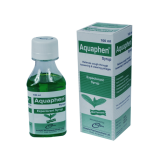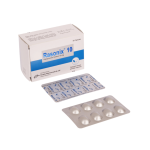Quiet(Quetiapine)
Therapeutic Group: Drugs of Nervous System

Presentation
Quiet 25: Each film coated tablet contains Quetiapine Fumarate USP equivalent to Quetiapine 25 mg.
Quiet 50 XR: Each extended release tablet contains Quetiapine Fumarate USP equivalent to Quetiapine 50 mg.
Quiet 100: Each film coated tablet contains Quetiapine Fumarate USP equivalent to Quetiapine 100 mg.
Quiet 200 XR: Each extended release tablet contains Quetiapine Fumarate USP equivalent to Quetiapine 200 mg.
Quiet 300 XR: Each extended release tablet contains Quetiapine Fumarate USP equivalent to Quetiapine 300 mg.
Description
Quetiapine Fumarate is an atypical psychotropic agent belonging to a chemical class, the dibenzothiazepine derivatives. Quetiapine is an antagonist at multiple neurotransmitter receptors in the brain: serotonin 5HT1A and 5HT2, dopamine D1 and D2, histamine H1 , and adrenergic α1 and α2 receptors. Quetiapine has no appreciable affinity at cholinergic muscarinic and benzodiazepine receptors. The mechanism of action of Quetiapine is unknown. However, it has been proposed that this drug’s efficacy in schizophrenia is mediated through a combination of dopamine D2 and serotonin 5HT2 antagonism. Quetiapine’s antagonism of histamine H1 receptors may explain the somnolence and that of adrenergic α1 receptors may explain the orthostatic hypotension observed with this drug. Elimination of Quetiapine is mainly via hepatic metabolism with a mean terminal half-life of about 6 hours. Steady-state concentrations are expected to be achieved within two days of dosing. Quetiapine is unlikely to interfere with the metabolism of drugs metabolized by cytochrome P450 enzymes. Quetiapine Fumarate is rapidly absorbed after oral administration, reaching peak plasma concentrations in 1.5 hours. The tablet formulation is 100% bioavailable relative to solution. The bioavailability of Quetiapine is marginally affected by administration with food, with Cmax and AUC values increased by 25% and 15%, respectively. It is 83% bound to plasma proteins at therapeutic concentrations. Following a single oral dose less than 1% of the administered dose is excreted as unchanged drug. Approximately 73% and 20% of the doses were recovered in the urine and feces, respectively. Quetiapine is extensively metabolized by the liver.
Indications
Bipolar Mania: Quetiapine is indicated for the treatment of acute manic episodes associated with bipolar disorder, as either monotherapy or adjunct therapy to
lithium or divalproex.
Schizophrenia: Quetiapine is indicated for the treatment of schizophrenia. Physician who elects to use Quetiapine for extended periods should periodically re-evaluate the long-term usefulness of the drug for the individual patient.
Dosage & Administration
• Schizophrenia-Adults
Initial dose and titration: Day 1: 300 mg/day Dose increases can be made at intervals as short as 1 day and in increments of up to 300 mg/day
Recommended dose: 400-800 mg/day
• Schizophrenia- Adolescents (13 to 17 years)
Initial dose and titration: Day 1: 50 mg/day; Day 2: 100 mg/day; Day 3: 200 mg/day; Day 4: 300 mg/day; Day 5: 400 mg/day
Recommended dose: 400-800 mg/day
• Bipolar Mania- Acute monotherapy or as an adjunct to Lithium or Divalproex
Initial dose and titration: Day 1: 300 mg/day; Day 2: 600 mg/day; Day 3: 400-800 mg/day
Recommended dose: 400-800 mg/day
• Depressive Episodes Associated with Bipolar Disorder
Initial dose and titration: Day 1: 50 mg/day; Day 2: 100 mg/day; Day 3: 200 mg/day; Day 4: 300 mg/day
Recommended dose: 300 mg/day
• Major Depressive Disorder, Adjunctive therapy with Antidepressants
Initial dose and titration: Day 1 & 2: 50 mg/day; Day 3 & 4: 150 mg/day
Recommended dose: 150-300 mg/day
Side Effects
Somnolence, dizziness, dry mouth, constipation, dyspepsia, postural hypotension, elevated ALT (SGPT) levels, weight gain
Precautions
Neuroleptic malignant syndrome, tardive dyskinesia. Hypotension and syncope, especially during the initial dose titration period. Conduct eye examinations prior to or shortly after starting Quetiapine and at 6-month intervals thereafter; discontinue the drug if clinically significant lens changes are observed. History of seizures. Hypothyroidism. Hyperprolactinemia. Antiemetic effect. Suicide. Use with great caution in moderate or severe hepatic impairments. Renal impairment, cardiovascular disease. Disruption of body temperature regulation. Hyperglycemia. Lactation (avoid breast-feeding)
Use in Pregnancy & Lactation
Pregnancy Category C. There are no adequate and well-controlled studies in pregnant women and Quetiapine should be used during pregnancy only if the potential
benefit justifies the potential risk to the fetus.
Nursing Mothers: It is recommended that women receiving Quetiapine should not breast feed.
Pediatric Use: The safety and effectiveness of Quetiapine in pediatric patients less than 13 years with schizophrenia, less than 10 years with bipolar mania and less than 18 years for bipolar depression have not been established.
Drug Interaction
May enhance the effects of other centrally acting drugs, certain antihypertensive agents; may antagonize the effects of dopamine agonists and levodopa. Increased clearance of Quetiapine by phenytoin, barbiturates, rifampin, carbamazepine. Increased concentrations of Quetiapine with azole antifungals and macrolide antibiotics.
Storage
Do not store above 30°C. Keep away from light and out of the reach of children
Commercial Pack
Quiet 25: Each box contains 5 blister strips of 10 tablets.
Quiet 50 XR: Each box contains 5 blister strips of 10 tablets.
Quiet 100: Each box contains 5 blister strips of 10 tablets.
Quiet 200 XR: Each box contains 3 blister strips of 10 tablets.
Quiet 300 XR: Each box contains 2 blister strips of 10 tablets.



